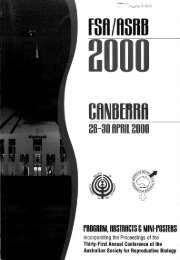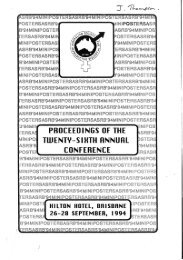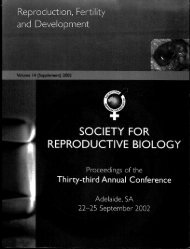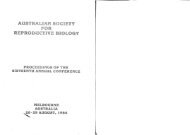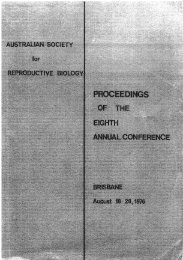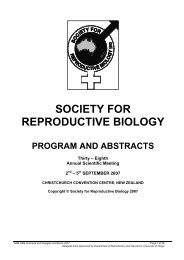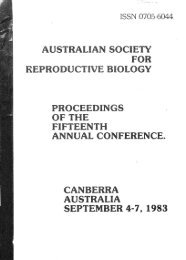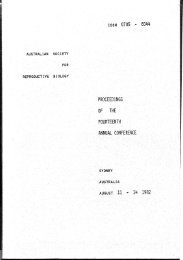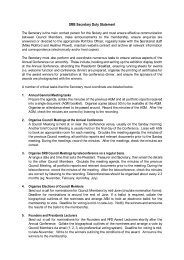N OCIETY' - the Society for Reproductive Biology
N OCIETY' - the Society for Reproductive Biology
N OCIETY' - the Society for Reproductive Biology
You also want an ePaper? Increase the reach of your titles
YUMPU automatically turns print PDFs into web optimized ePapers that Google loves.
MICROARRAYS: MICRO OR MACRO POTENTIAL?The Effect of Cyclic-Nucleotides on Fluid Reabsorptionin <strong>the</strong> Ductuli Efferentes Testis of <strong>the</strong> Rat.Suet Y. Man, John Clulow and Russell C. JonesDepartment of Biological Sciences, University of Newcastle, NSW2308, Australia.Michael J McKayPeter MacCallum Cancer Institute, St Andrews Place, Melbourne, AustraliaThe development of DNA microarray technologies over <strong>the</strong> last few years has heralded a potential<strong>for</strong> providing new, sharp, tools <strong>for</strong> application to many questions in biology and medicine. At thisrelatively early stage, however, it is unclear as to what <strong>the</strong> true impact of microarrays, or DNAChips, will be. Various types of microarrays have been developed, including normal tissue- andtumour- derived arrays (generated from pathological specimens) and proteomic approaches. Thispresentation will focus on mRNA-based systems, with a particular emphasis on RNA expressionprofiling and some of <strong>the</strong> strategies and common pitfalls which might be considered by thoseplanning microarray experiments. O<strong>the</strong>r applications of RNA microarrays will be brieflyconsidered.Two main RNA microarray strategies are now in relatively common use. These are oligonucleotidearrays, typically based on photolithographic deposition of DNA on silicon, and arrayed cDNAs,derived from known genes or expressed sequence tags (ETSs). eDNA arrays can comprise completeor partial cDNA fragments.Some work towards developing mRNA-based microarrays in Australia will be discussed, illustratedby specific research questions, mainly in <strong>the</strong> field of cancer, to which microarray analysis is beingapplied.IntroductionRecent work has shown that <strong>the</strong> ductuli efferentesare essential <strong>for</strong> male fertility (1). We have shownthat <strong>the</strong> ductuli reabsorb 96% of <strong>the</strong> fluid leaving<strong>the</strong> testis and that <strong>the</strong> reabsorption is dependent onfluid flow rate and Na+ concentration of <strong>the</strong>perfusate(2,3). Our previous studies havedemonstrated that luminally adminstered cAMPsuppresses fluid reabsorption in <strong>the</strong> ductuliefferentis (4), indicating that <strong>the</strong> cAMP signaltransduction pathway is involved in controllingfluid reabsorption in <strong>the</strong> ductuli of <strong>the</strong> rat. In <strong>the</strong>homologous proximal kidney tubule, cGMP hasalso been reported to reduce tubular reabsorption(5). The current study was undertaken to determinewhe<strong>the</strong>r cGMP has an effect on <strong>the</strong> fluidreabsorption in <strong>the</strong> ductuli efferentes.Materials and MethodsMicroperfusion experiments were per<strong>for</strong>med onanaes<strong>the</strong>tized male Wister rats. A length ofefferent duct was isolated and perfused withKrebs-ringer bicarbonate solution containingdifferent concentrations of dibutyryl-cGMP at arate of 0.1 JlJ.min- 1 • The reabsorption rate wascalculated from <strong>the</strong> volume difference between <strong>the</strong>perfusate and collectate divided by <strong>the</strong> length of<strong>the</strong> perfused duct. Electrolyte composition in <strong>the</strong>collectate was determined by energy-dispersivespectroscopy.ResultsTable 1 shows that <strong>the</strong> fluid reabsorption in <strong>the</strong>ductuli efferentes is not significiantly changed by0.1-1.0mM dibutyryl-cGMP in <strong>the</strong> luminalperfusate. cGMP has no effect on reabsorption atconcentrations at which cAMP completelyabolishes reabsorption. Fu<strong>the</strong>rmore, <strong>the</strong>re is nosignificant difference in <strong>the</strong> concentrations of Na+,K+ and cr , <strong>the</strong> major luminal ions, in <strong>the</strong>collected fluid between <strong>the</strong> control and dibutyrylcGMP-treatedgroups (Table 2).DiscussionOur results strongly suggest that cGMP is not <strong>the</strong>second messenger mediating fluid regulation in <strong>the</strong>ductuli efferentes. By contrast, both cGMP andcAMP are reported to mediate fluid reabsorptionin <strong>the</strong> proximal renal tubules (6,7). The Na+/H+exchanger has been reported as one of <strong>the</strong>principal transporters responsible <strong>for</strong> fluid andelectrolyte reabsorption in <strong>the</strong> ductuli efferentes(8) and its function could be regulated by cAMP asin <strong>the</strong> proximal tubules.Table 1. Effect of Dibutyryl-cGMP and DibutyrylcAMPon Fluid Reabsorption in Perfused RatDuctuli Efferentis. Mean + S.. E M ., * P



